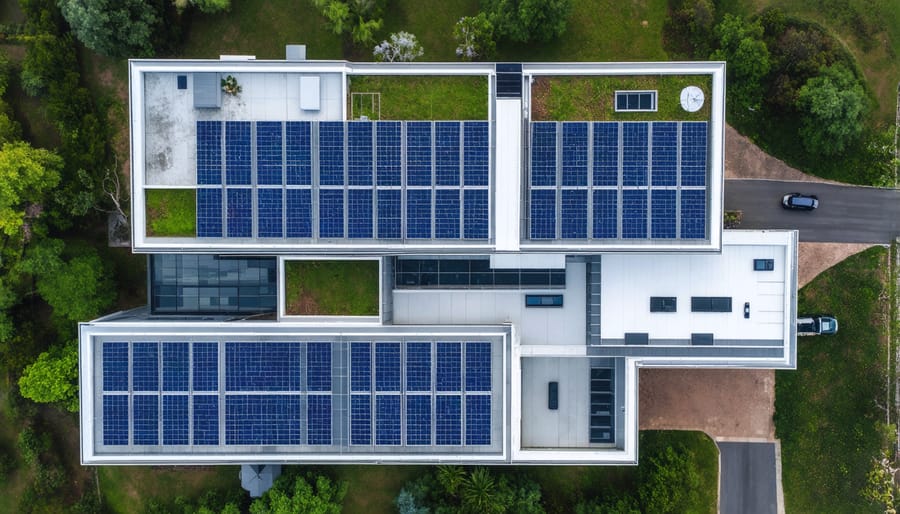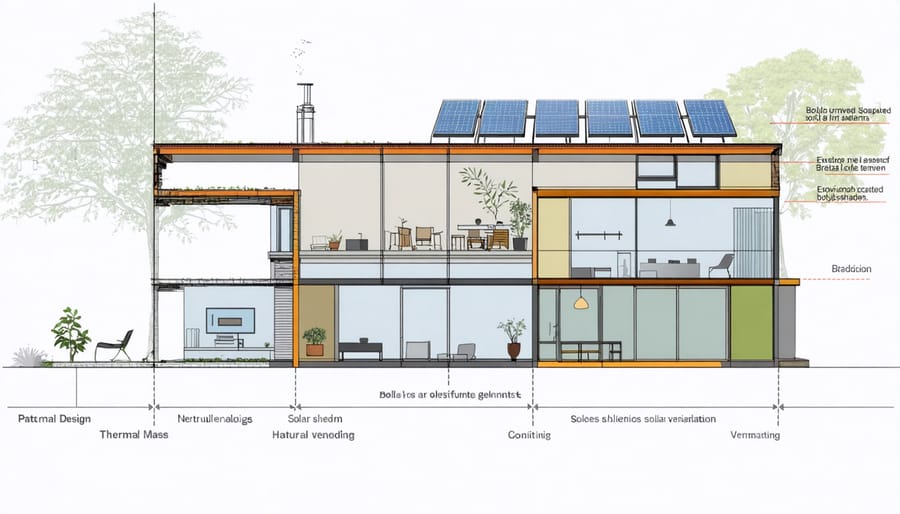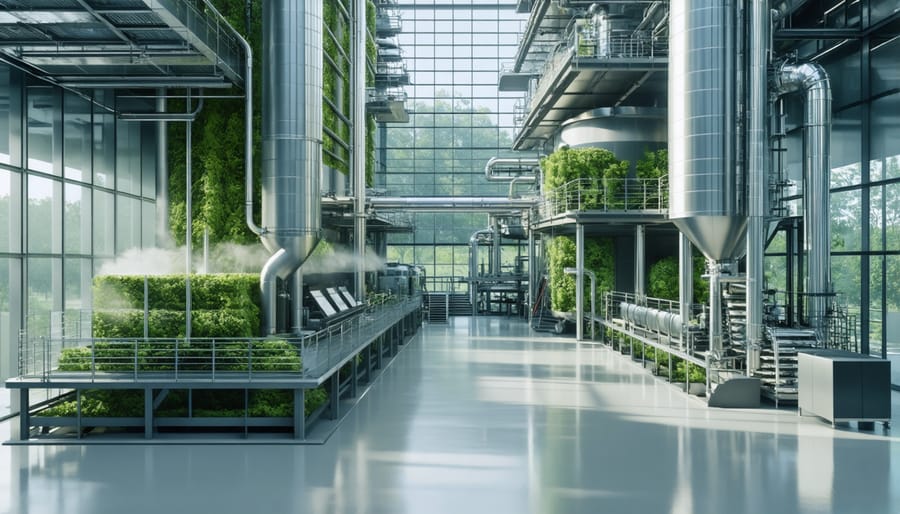As extreme weather events intensify and temperatures continue to rise, climate-resilient buildings have emerged as our first line of defense against environmental challenges. These architectural marvels don’t just withstand nature’s fury – they adapt, respond, and thrive in changing conditions while minimizing their environmental impact.
Australia’s unique climate, from scorching summers to devastating floods, demands innovative building solutions that go beyond traditional construction methods. Forward-thinking architects and engineers are revolutionizing our approach to building design, creating structures that not only protect occupants from extreme weather but actively contribute to climate change mitigation.
Climate-resilient buildings represent a perfect fusion of cutting-edge technology and sustainable design principles. They incorporate advanced materials, smart systems, and passive design strategies to maintain comfort while dramatically reducing energy consumption. From green roofs that manage stormwater and reduce urban heat to adaptive façades that respond to changing weather conditions, these buildings showcase how thoughtful design can create spaces that are both environmentally responsible and remarkably resilient.
As our cities evolve to meet the challenges of climate change, these innovative building solutions aren’t just desirable – they’re essential for creating a sustainable, livable future.
The Climate Challenge for Australian Buildings
Extreme Weather Events
Australia’s weather patterns are becoming increasingly extreme, challenging our traditional building approaches. Recent years have seen unprecedented heat waves pushing temperatures above 40°C in major cities, while severe storms and flooding events have caused billions in damage to properties across the country.
The Black Summer bushfires of 2019-2020 demonstrated how extreme weather can threaten our buildings, while the 2022 floods in Southeast Queensland and Northern NSW showed the devastating impact of intense rainfall events. These aren’t isolated incidents – they’re part of a growing pattern that’s reshaping how we think about building design.
Climate scientists predict these extreme weather events will become more frequent and intense. Heat waves are expected to occur more often and last longer, while storms are likely to bring heavier rainfall in shorter periods. Coastal areas face additional challenges from rising sea levels and storm surges.
For building owners and designers, this new reality demands innovative solutions. The good news is that we’re getting better at predicting and preparing for these events, with advanced weather monitoring systems and improved building technologies leading the way in creating more resilient structures.

Energy Demand Pressures
As our climate continues to warm, buildings face unprecedented pressure from increasing cooling demands. Australian cities are experiencing more frequent heatwaves, driving up energy consumption and straining power grids during peak periods. This challenge is particularly acute in urban areas, where the heat island effect intensifies cooling requirements.
Modern buildings must adapt to these changing conditions while managing peak energy demands effectively. During summer months, air conditioning can account for up to 40% of a building’s total energy consumption, creating significant spikes in electricity usage during the hottest parts of the day.
The good news is that innovative design approaches and smart technologies are helping buildings become more resilient to these pressures. Advanced building management systems, thermal storage solutions, and passive cooling strategies are working together to reduce peak loads while maintaining comfortable indoor environments. Many Australian buildings are now incorporating these solutions, demonstrating that it’s possible to stay cool while keeping energy consumption in check.
Smart Design Features for Climate Resilience
Passive Solar Design
In Australia’s diverse climate zones, passive solar design stands as a cornerstone of climate-resilient architecture, offering natural solutions for maintaining comfortable indoor temperatures while minimizing energy consumption. This approach harnesses the sun’s energy and natural airflow patterns to create buildings that work in harmony with the environment.
Strategic window placement plays a crucial role, with north-facing windows capturing winter sun while being easily shaded during summer months. Thermal mass materials like concrete floors and rammed earth walls store heat during winter days and release it gradually at night, while providing cooling effects during summer. These features work alongside advanced energy storage solutions to maximize efficiency.
Cross-ventilation is particularly effective in Australia’s coastal regions, where clever window and door positioning creates natural cooling pathways through buildings. In hotter inland areas, thermal chimneys and solar ventilation systems help expel warm air while drawing in cooler air from shaded areas.
Incorporating native vegetation around buildings provides natural shade and creates microclimate zones that reduce ambient temperatures. Deciduous trees on the northern side offer summer shade while allowing winter sun penetration, and native vines on trellises can shield western walls from harsh afternoon sun.
The success of passive solar design is evident in projects like the award-winning Sustainable Buildings Research Centre in Wollongong, which maintains comfortable temperatures year-round with minimal mechanical heating or cooling. These principles are increasingly being adopted in both residential and commercial construction, proving that working with nature rather than against it is both cost-effective and environmentally responsible.

Advanced Building Materials
The evolution of building materials has revolutionized our approach to climate resilience, with Australian innovations leading the way in heat-resistant and energy-efficient solutions. Cool roof technologies, incorporating advanced reflective coatings and specialized tiles, can reduce indoor temperatures by up to 7°C during peak summer heat, significantly decreasing cooling costs and energy consumption.
Phase-change materials (PCMs) represent a groundbreaking advancement in thermal regulation. These sophisticated materials absorb and release heat as they transition between solid and liquid states, effectively maintaining consistent indoor temperatures throughout daily temperature fluctuations. When integrated into walls and ceilings, PCMs can reduce heating and cooling needs by up to 40%.
Engineered timber products, particularly cross-laminated timber (CLT), have emerged as sustainable alternatives to traditional construction materials. Not only do they sequester carbon, but they also provide excellent thermal insulation. Australian-grown engineered timber products are increasingly being used in commercial and residential buildings, offering both environmental benefits and superior fire resistance.
Smart glass technology has transformed window systems, automatically adjusting its tint based on sunlight intensity and temperature. This dynamic response helps maintain optimal indoor conditions while reducing energy loads. Similarly, aerogel-based insulation materials, though currently premium products, offer exceptional thermal resistance at a fraction of traditional insulation thickness.
Local manufacturers are also developing composite materials that combine recycled content with enhanced durability. These materials not only reduce waste but also demonstrate improved thermal performance and weather resistance. For instance, innovative concrete mixes incorporating recycled glass and plastic aggregates show promising results in both strength and thermal properties, marking a significant step toward sustainable construction practices.
Bioenergy Integration in Building Systems
On-site Bioenergy Generation
On-site bioenergy generation represents a game-changing approach to making buildings more climate-resilient while reducing their environmental footprint. In Australia, where sustainable building practices are gaining momentum, building-integrated bioenergy systems are emerging as a practical solution for both urban and rural developments.
These systems typically harness organic waste materials, such as food scraps, garden clippings, and agricultural residues, converting them into usable energy through processes like anaerobic digestion or biomass combustion. The Ballarat Community Health Centre offers an inspiring example, where its bioenergy system processes local organic waste to generate both electricity and heating for the facility.
What makes on-site bioenergy particularly attractive is its dual benefit of waste management and energy production. For instance, the Crown Plaza Hotel in Melbourne implemented a food waste-to-energy system that reduces their waste disposal costs while providing supplementary power for their operations.
The integration of these systems requires careful planning and consideration of available biomass resources. Many successful implementations in Australia combine bioenergy with other renewable sources, creating resilient hybrid systems. The University of Queensland’s Gatton campus demonstrates this approach, using a combination of solar power and bioenergy to achieve greater energy independence.
For building owners considering bioenergy integration, local councils often provide support and incentives. The technology continues to evolve, with newer systems becoming more compact and efficient, making them suitable for various building types and scales.

Smart Grid Connection
The integration of climate-resilient buildings with modern power infrastructure represents a significant leap forward in sustainable urban development. By connecting to decentralized energy systems, these buildings become active participants in the broader energy ecosystem, contributing to grid stability and resilience.
Smart grid integration enables buildings to dynamically respond to energy demand and supply fluctuations, optimising power consumption during peak periods and storing excess energy for later use. This two-way communication between buildings and the grid creates a more flexible and efficient energy network, particularly valuable during extreme weather events or grid disruptions.
In Australia, forward-thinking developments are incorporating advanced energy management systems that prioritise smart grid security while enabling seamless integration with renewable energy sources. These systems allow buildings to participate in demand response programs, automatically adjusting their energy use based on grid conditions and price signals.
The benefits extend beyond individual buildings to strengthen entire communities. During heatwaves or storms, smart grid-connected buildings can share power resources, maintaining essential services and reducing strain on the main grid. This interconnected approach creates a more resilient urban environment, where buildings work together to maintain comfort and functionality regardless of external conditions.
Success Stories: Australian Climate-Resilient Buildings
In the heart of Melbourne’s bustling business district, the Pixel Building stands as a pioneering example of climate-resilient architecture. Completed in 2010, this revolutionary structure achieved Australia’s first carbon-neutral building status and showcases multiple adaptive features, including a facade that automatically adjusts to weather conditions and a smart rainwater harvesting system that reduces water consumption by 70%.
The University of Queensland’s Global Change Institute in Brisbane demonstrates how traditional Queensland architecture can be reimagined for climate resilience. The building features operable sun shading, natural ventilation, and an advanced building management system that responds to weather conditions in real-time. During the 2022 Brisbane floods, the building’s elevated design and water-resistant materials proved invaluable in minimizing damage and maintaining operations.
In Sydney’s Barangaroo precinct, International Towers Sydney sets new standards for climate resilience. These buildings employ a combination of passive design principles and cutting-edge technology, including double-skin facades that regulate heat transfer and smart sensors that optimize energy usage. The towers have maintained comfortable indoor temperatures even during extreme heatwaves, while reducing energy consumption by 30% compared to conventional buildings.
The SA Water House in Adelaide showcases how water-sensitive design can enhance climate resilience. The building’s innovative blackwater treatment system recycles 100% of its water, while its adaptive cooling system uses captured rainwater for temperature regulation. During South Australia’s recent drought periods, the building maintained full functionality while reducing potable water consumption by 90%.
In regional Australia, the Wodonga Library demonstrates climate resilience doesn’t require big-city budgets. The building’s clever use of thermal mass, natural ventilation, and local materials has created a comfortable community space that withstands extreme temperatures while minimizing energy costs. During the 2019-20 bushfire season, the building served as a clean air shelter for the community, thanks to its advanced filtration systems.
These success stories prove that climate-resilient buildings are not just theoretical concepts but practical, achievable solutions that deliver real benefits to occupants and owners alike. They demonstrate how thoughtful design, combined with modern technology, can create structures that not only withstand climate challenges but thrive in spite of them.
As we look to the future of sustainable architecture in Australia, climate-resilient buildings represent more than just a trend – they’re becoming an essential part of our response to environmental challenges. The integration of advanced materials, smart technologies, and bioenergy systems has demonstrated that buildings can not only withstand extreme weather events but also contribute positively to our environment.
The success stories we’ve explored, from Melbourne’s sustainable skyscrapers to Brisbane’s adaptive residential complexes, show that climate resilience is achievable across different building types and scales. These projects prove that combining passive design principles with cutting-edge technology creates structures that are both environmentally responsible and economically viable.
Looking ahead, the future of climate-resilient architecture in Australia appears promising. With continued advances in building materials, energy storage solutions, and weather prediction systems, our buildings will become even more adaptive and responsive to environmental changes. The growing emphasis on green certification and sustainable building codes suggests that climate resilience will become standard practice rather than an optional extra.
The challenge now lies in scaling these solutions across our cities and regions. By embracing innovative designs, supporting sustainable technologies, and fostering collaboration between architects, engineers, and policymakers, we can create a built environment that not only survives but thrives in the face of climate change. The path forward is clear: climate-resilient buildings are no longer just an option – they’re the foundation of our sustainable future.

